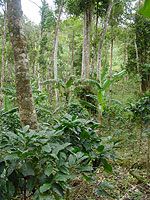Civet Coffee
Only about 50 kilos of this blend is collected per year, making it the ultimate in exclusivity and rarity. The primary reason for Civet Coffee's distinctive taste is that it's been partially fermented by passing through the digestive system of a Sumatran Civet Cat. Basically this feral feline prowls Sumatran coffee plantations at night, choosing to eat only the finest, ripest cherries. The stones (which eventually form coffee beans) are then collected by sifting through the Civet's number twos.Revered for its luscious chocolatey flavour Civet Coffee is totally safe, totally sterilised and totally delicious. Plus there's no discernable aftertaste.Native Sumatrans consider this to be the finest coffee in the world.
You can it at
• www.firebox.com
What is Shade-Grown Coffee?

Economic pressures mean that coffee plantations most frequently rely on sun-grown methods of production. These plantations are "monocultures" - i.e. the only crop grown is coffee. These methods increase soil erosion and also require constant applications of fertilizers and pesticides - and, of course, are unfriendly to wildlife because of habitat destruction, thus leading to loss of bio-diversity.
 |
| Sun-Grown Coffee Plantation |
Consider that around 50% of cropland in Central America, around 40% in Latin America and almost 10% of land in El Salvador is given over to coffee production. Worldwide, coffee production is second in importance only to oil. This has led to substantial deforestation in Central and South America.
There has been a documented decline of many songbird species in North and South America and, although the exact reasons for this decline are not agreed upon by scientists studying the problem, it is widely accepted that habitat loss is an important factor.
In its native Africa, the coffee plant evolved as a shade tolerant forest species, growing in the shade of a tree canopy. In good conditions, the plant can grow up to 30 feet. Sun tolerant varieties are hybrids that were developed in the 1970s. They tend to be smaller and shorter lived than the shade tolerant varieties.
Shade-grown methods of coffee production replicate these "natural" conditions by maintaining a tree canopy over coffee shrubs. They also avoid the many problems associated with sun-grown coffee plants.
Currently, the coffee from shade-grown sources is slightly more expensive than that from sun-grown sources. This is because sun tolerant hybrids have been developed for high yield. So, despite the obvious advantages of shade-grown, economic pressures prevail.
 |
| Shade-Grown Coffee Plantation |
It is often quite difficult to find shade-grown coffee on sale - even the sites listed on Easytorecall that sell organic, fair trade products are shy when it comes to specifying whether or not a particular coffee is shade grown or not. Organic/fair trade does not necessarily mean shade-grown when it comes to coffee, although we understand that something in the region of 80% of certified fair trade coffee is also shade grown.
One feature to look out for is if a supplier is registered with the Rainforest Alliance. Rainforest Alliance Certified farms must adhere to the following standards:
- New and expanding farms must not degrade, damage or destroy ecosystems.
- Areas not suitable for cultivation should be reforested or restored to natural state.
- On a productive farm, at least 40% of the ground should be shaded.
- At least 70% of the trees in the productive part of the farm must be evergreens.
- Epiphytes on shade trees should be conserved. (Important for the song birds.)
- The use of fire to clear land is prohibited.
- Hunting is prohibited.
- Materials should be reused as many times as possible.
- Organic wastes must be used to enrich the soil.
- Recycle plastic, paper, wood, metals and glass.
More information:
www.seattleaudubon.org
http://eartheasy.com
www.fincaesperanzaverde.org
Can't find it?
Try our search engines, price comparison and online auction pages.




